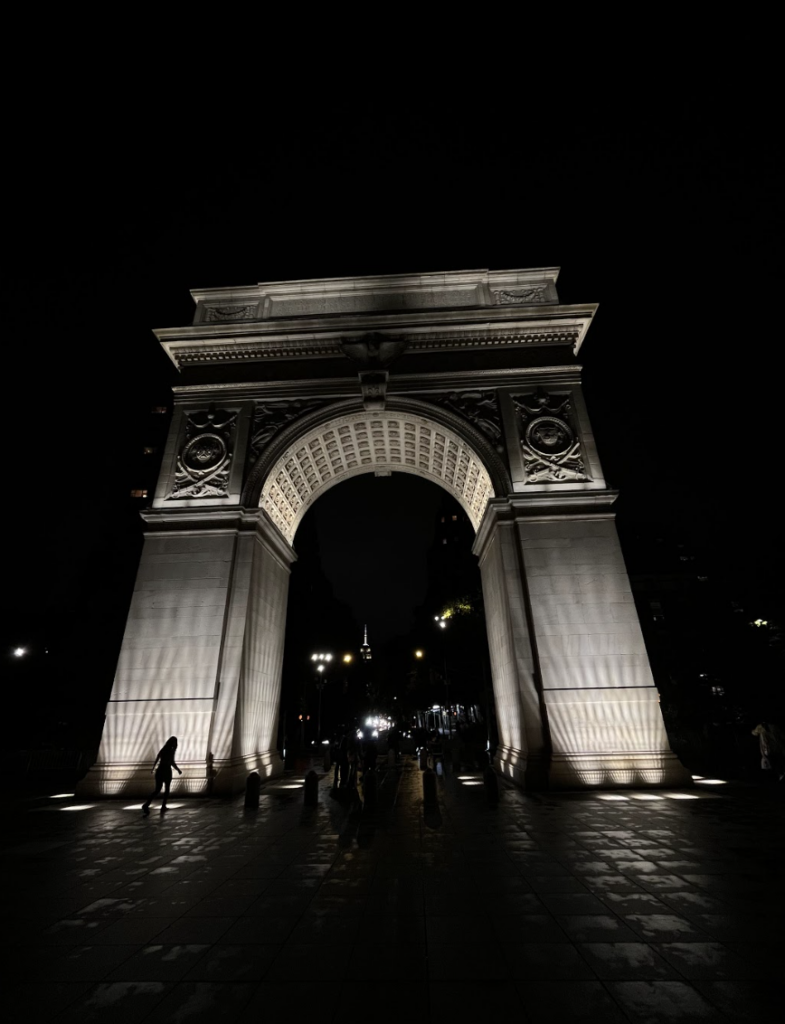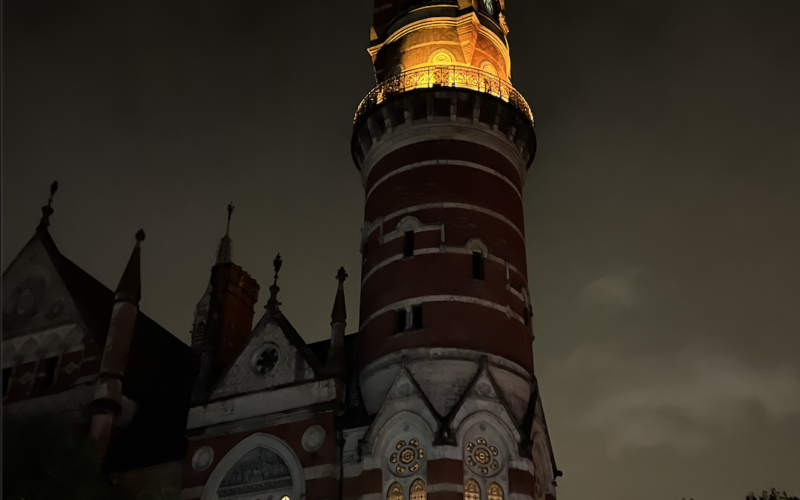NYC’s Invisible Citizens: The Ghosts
Media provided by Elif Caliskan ’25 and Veronica Hatch ’25
People travel from all over the world simply to observe the bright lights of New York City. Whether it is day or night, NYC is constantly bustling with people, hence its renowned description of being, “the city that never sleeps.”
As the spirited people of this metropolis take advantage of the lively nights in “the Big Apple”, they are being watched by the city’s invisible residents: Ghosts! Avid city goers typically feel unconcerned by the concept of ghosts, as the streets are filled with seemingly more imminent dangers. However, with Halloween being just around the corner, people are better off if they open their eyes and grow wary of the spirits meandering through the night breeze in search of a soul to devastate.
If Times Square is the center of New York City’s people, Washington Square Park is the center of its dead. Hundreds of people pass by the grounds in a single hour. The common crowds of Washington Square Park typically consist of street dancers, artists, NYU students, and teenagers who had nothing better to do that evening. Yet as a multitude of people take their leisurely strolls throughout the park, the true identity of the park often goes unrecognized. Buried under the colossal fountain, the grand marble arch of Washington, the tall linden trees, the cement the skaters grate, and the green grass dug up by squirrels lay the remains of 20,000 plagued bodies.
According to the official website of the park, the yellow fever outbreak of 1795-1804 killed people at an unprecedented rate. As if the plague was not bad enough, the city faced another problem. There wasn’t enough space for the dead. The plot where Washington Square Park stands today was purchased for burying bodies, usually by piling them on top of each other. Calling these burial sites “a potter’s field,” urban poor, indigent people, and yellow fever victims were laid to rest with neither a coffin nor a tombstone. Then, and perhaps because of this injustice to their souls, they became restless.

Following the end of the plague, the burial ground quickly became full, and the city officials decided in 1826 that the cemetery would be more beneficial to the economy and the real estate if it was made a communal park. The potter’s field was leveled and groomed to foster new life on the soil that covered the dead. The souls of the deceased began to water the roots of the living as the ground was officially renamed Washington Parade Ground on July 4, 1826. As the decaying remains of the impoverished were left to fester, the neighborhood’s affluence flourished.
Unfortunately for the NYC inhabitants, the ghosts and spirits have risen from their forlorn doom and begun conversing with the people in an eerie fashion. The bodies of the unclaimed were not given a proper release from life and were trapped there under the green. Perhaps in search of peace and recognition, they began to haunt Greenwich Village. The homes that rise around Washington Square Park were frequented by the ghosts and spirits of the dead whose remains were hurled beneath. Mark Twain’s house was among them, and the spine-chilling tale of his nightmarish abode is worth exploring.
This ghost story begins on 14 West 10th Street, now called “the house of death.” It holds a sordid past. The house of death is said to be inhabited by numerous ghosts. Its most popular tenant was Mark Twain, and despite his passing, Twain was believed to have come back to visit this fairground of ghosts. According to a tour guide from NYC Ghost Tours, Twain’s ghost is rumored to be prowling around in the building, cloaked in a white suit that Twain himself preferred to wear almost every day. A ghost imitating a famous artist is a testament that they are, after all, too human.
The property appeared to take on the epithet of “the house of death,” after Mark Twain passed away. He had lived in the apartment for only two years and passed away in 1910 from a heart attack a mere two years after leaving the residence. Perhaps the ghosts wore his heart down, or a paranormal event left him so afraid that his heart stopped beating. Whether the death of Twain came as a result of living in “the house of death,” or rather due to an unfortunate medical catastrophe, is still up for debate. Yet the countless remarks of his seemingly haunted residence leave the skeptical with an easy answer.
Mark Twain’s corpse now rests in Elmira, New York’s Woodlawn Cemetery. However. his ghost resides in “the house of death”. By 1937, the house had been converted into an apartment, housing a multitude of residents, who each served to increase the number of ghostly reports. Consecutive tenants have reported seeing Samuel Langhorne Clemens, better known as Mark Twain’s apparition, ascending the stairs, which are regarded as the building’s most haunted site. He might also be to blame for the inaudible murmuring marching sounds occasionally heard throughout the house’s vacant areas.
Mark Twain’s Ghost, along with others who occupy the house, are more than just an urban legend. Ghosts from all across New York are drawn to 14 West 10th by an attraction too shady to be seen with the bare eye. A popular ghost tour in NYC, organized by NYC ghosts , informed to the tourists that the ghost of Mark Twain allegedly appeared to a lady who had just moved into the building with her daughter. The spirit ominously declared, “My name is Clemens, and I have a problem here that I need to settle.”
The Greenwich Village ghost tour, organized by NYC Ghosts, depicted numerous appalling stories from residents of “the house of Death,” about the bizarre and unexplainable experiences with the house. One of the residents, Jan Bryant Bartell, was profoundly troubled by her experience in “the House of Death,” in which the tour guide discussed Bartell’s case with an enhanced sense of horror.
Bartell was a poet, educator, and actor who had roles in plays including “Bell, Book, and Candle” and “Night Must Fall.” Bartell, alongside her husband, moved into one of the apartments in 14 West 10th. From the outside, the apartment looked to be a gorgeous brownstone, adorned with incarnadine stone blocks, but on the inside was filled with ghosts that made the property just as grim and cold as a corpse. The only splash of color inside was the crimson blood the spirits sought, like the one of Bartell’s.
After living in “the House of Death” for an extended period of time, Bartell began recording every aspect of her stay in the apartment. She claimed to have felt a presence she could not see but only felt, pulling her deep into insanity. Throughout her stay in the house, she reported to experience psychological and occasionally physical anguish from what she claimed were the frigid hands of the house’s previous occupants reaching out from the afterlife to grasp her. Evidently, the shadows in this home are more than just a darkness that follows, they are ones that become you.
Due to her experiences, Bartell wrote a meticulous recount of her days consumed in 14 West 10th Street titled “Spindrift: Spray from a Psychic Sea.” You may now find the book on Amazon, but the price ranges around the hundreds. The introduction of the book states, “When it all began, Jan Bartell did not believe in a spirit world, a world she could not see. She simply loved antiques and old houses. When she found the apartment in a townhouse in New York’s Greenwich Village, on a quiet tree-shaded street, her troubles began and they did not let up for 12 years. But, despite the strange shadows and unexplainable sounds that seemed to occur frequently, all was not terror and dread. Her fears were mixed with curiosity. She wanted to know what it was that seemed to clutch at her in the dark; she wanted to understand what it was that seemed to follow her as she moved about her apartment. So she began to investigate old books of mysterious and esoteric knowledge. She called upon famous mediums and professional ghost hunters to try to unlock doors.” Following the publication of her book, Bartell stepped into her own mysterious demise, when she died of unknown reasons in 1973.
This tale doesn’t end with one death, as the curse of this house continues to touch upon new spirits, more innocent and young. The townhouse continued to carry out its notorious reputation of being “the House of Death,” when Joel B. Steinberg and his two adopted children — Elizabeth, 6, and 16-month-old Mitchel — moved in.
On a cold November day in 1987, Elizabeth Steinberg and her brother were found in a frightening state. Elizabeth Mehren wrote for the Los Angeles Times, stating, “when officers and technicians arrived at the Greenwich Village apartment, they found an infant boy [dead]. Blood was splattered on the walls and on the single mattress the family shared.” On the kitchen floor lay 6-year-old Elizabeth. (Mehren) Although the children were rushed to emergency care, Elizabeth Steinberg sadly did not make it. The New York Times stated that Joel B. Steinberg refused to plead guilty for the filed assault and murder charges, claiming him and his adopted children always had a loving relationship. He appeared to be under the influence of a variety of substances, including ghosts, who have a reputation for driving residents into a state of insanity.
While most city goer’s remain unfazed by the hazardous activities witnessed each day, the story of Twain’s house is one that is impossible to shake. To this day, “the House of Death” continues to haunt its residents and is infamous for its ghosts and dark past. If you dare, include “the House of Death” and Washington Square Park in your bucket list of sights to visit during Halloween. Yet you must beware of famous ghosts of dead authors, flying around in white suits, as you never know whether a blood hungry spirit will pursue your death next.

